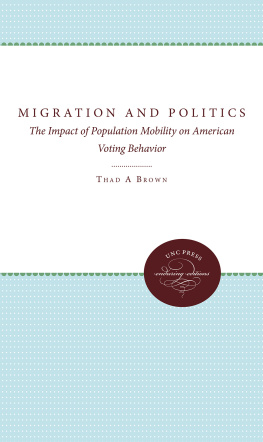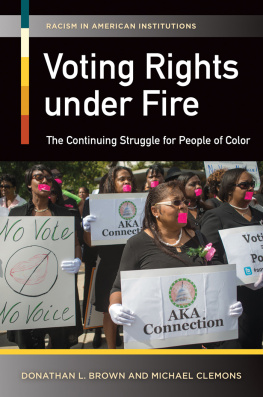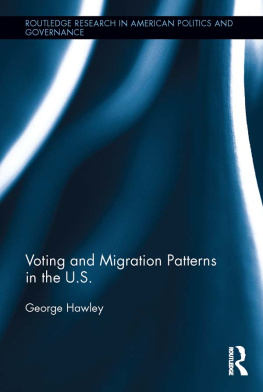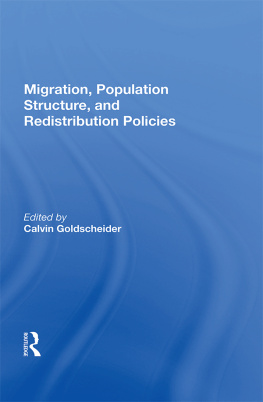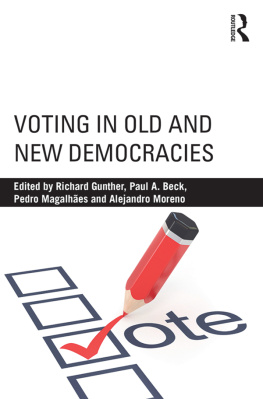1988 The University of North Carolina Press
All rights reserved
Manufactured in the United States of America
Library of Congress Cataloging-in-Publication Data
Brown, Thad A.
Migration and politics.
Bibliography: p.
Includes index.
1. ImmigrantsPolitical activity. 2. Political participation. 3. Emigration and immigrationPolitical aspects. I. Title.
JV6255.B76 1988 323.32 87-16240
ISBN 0-8078-6514-1
The paper in this book meets the guidelines for permanence and durability of the Committee on Production Guidelines for Book Longevity of the Council on Library Resources.
92 91 90 89 88 5 4 3 2 1
Design by Kaelin Chappell
Acknowledgments
The intellectual roots of this research reach back to when migration was first linked to political behavior by Warren E. Miller in his chapter on population movement in The American Voter (Campbell et al. 1960). His article on one-party politics showed the importance of lopsided local political environments to individual behavior (Miller 1956). Jacek Kugler insisted that migrants had to change politically. Samuel J. Elders veld suggested estimating past and current political environments as a way of discovering the effects of migration on citizens. John Sprague and William M. McPhee did pioneering theoretical work on social and contextual effects that informed the spirit of the analysis.
I would like to thank Judith Blake, Ivor Crew, Sam Kernell, Kathleen Knight, Vivian Lew, Dwaine Marvick, John R. Petrocik, Judith L. Powers, Allen A. Russell, David O. Sears, Elizabeth Stephenson, Morry Tolmach, and Donald J. Treiman. Each gave very useful advice and continued support. My colleagues at the University of Missouri-Columbia deserve a special note of thanks for their kindness and generosity.
I would also like to thank Karen Baum, Robert Hardy, Megan Hays, Elizabeth H. Hazard, Paul Hoffman, Charles Hofacker, Shirley Nordhaus, Mette Wadleigh, and Mel Widawski, for their assistance.
Lewis Bateman of the University of North Carolina Press provided the carrot and the stick. Stephanie Sugioka copyedited the manuscript with great care, and Sandra Eisdorfer provided excellent editorial advice.
Introduction
Attempts to understand migration have often relied upon reconstructing the past with the stories of those who moved and the nature of the times in which they lived. And while this book is aimed at objectively re-creating the experiences of migrants and their environments, and in assessing the political consequences of population movement, it is useful to keep in mind the human drama of migration.
Like most, my family migrated. When he was young, my fathers family moved from Ballinger, Texas, to Arkansas and Louisiana and back to Texas so many times that half his six brothers and sisters were born in different states. My mother was born in New York of immigrant parents. Toward the end of World War II, she was living in Alabama, working in a town hospital. She never much liked the South, its climate or its ways. After marrying in Alabama, my parents returned to New York to find work and to begin a new life. And in the early 1950s they moved to California to work and to be near family. My father never adjusted to cities and forever wanted to return to the South, to Texas. He never made it back.
Tracking the movement of just my mothers side of the family gives a typical portrait of migration. My mothers brother was the first to move West. He left New York to attend a university in Colorado. He married a young woman from the West and found his first job in the growing aircraft industry in Los Angeles. After my mother joined her brother, my grandparents also left New York for California to begin semiretirement and to be close to their children, grandchildren, and friends.
At one point, nearly a dozen relatives and close friends of my family moved to California from other parts of the country. Among them were my mothers friends and their families from the 600 block of North Sixth Avenue in Mount Vernon, New York. Many of my mothers generation had attended Our Lady of Victory Catholic Church. The neighborhood in New York was at least two generations old. It was Irish and Italian. By the time of my mothers generation, the closeness of the families in the neighborhood had blurred kinship lines. An example makes this point. Two brothers were once orphaned at an early age. They were not sent to live with distant relatives nor made wards of the state. Both boys were taken into the homes of families in the neighborhood to be raised as their own. They could not do less. Many in the neighborhood had been raised by friends of their deceased families.
In California, most who migrated have prospered. They are lawyers and engineers and other professionals. But at the end of three decades, they do not see each other very often. They have new old friends. They live in different parts of Los Angeles, but it might as well be different parts of the country. From my mothers generation a few have returned to New York. Several got divorced. None of the children of my generation knows the others well, nor cares to.
I recently returned to the neighborhood in New York that my family left over thirty years ago. Many friends and relatives of my mothers generation are still there. They are close to one another. Their children are friends, and many have married and stayed within the neighborhood or close by. Family seems very important. Their religion seems very important. Their ethnicity seems important.
On the streets around Mount Vernon there were signs of a coming election. The Democrats run the place. Italians seem to be the dominant group within the party. Signs to support one candidate or another were stuck in lawns in front of many houses, placed in shops and stores, and nailed to telephone poles. There was also an Italian community center in the neighborhood that seemed to have an active role in the election.
To me those who migrated are very different from those who stayednot only in where they live but in how they live. They hold different values, and different too are their hopes for the future and their ties to the past.
In my family those who moved to California are not rugged individualists, extremists, or ideologues. They also are not loyal Democratic partisans, nor are they active in Italian community organizations. Their politics, much like their religion and other group attachments and loyalties, have been shaped by their personal experiences in California. Their jobs, their new neighborhoods, their community, and their friends have forged new lasting political orientations that are rooted in different political values than are found in Mount Vernon.
Their move West represents a typical form of chain migration, individuals moving to be near kin and family. Yet individual members had to live and to work on a day-to-day basis apart from their traditional support groups. As a consequence, the family, the glue that binds individuals to the politics they inherit, has been eroded by changed circumstances. In the West social group ties changed, and with them the political behavior of my family changed from the way it would have been had they not moved.
Each one who leaves home and moves far away begins a new life. The accounts of migrants and their experiences, unlike the biographies of great political leaders or accounts of major political events, are about how everyday life has changed from the way it was elsewhere. Those stories, if they are truthfully told, might reveal the devastating human costs in terms of the pain and the terror of migration. They also might include the rags-to-riches dreams that come true. I doubt if this is too different today than it was when the country was new and the frontier was the last place settled.

